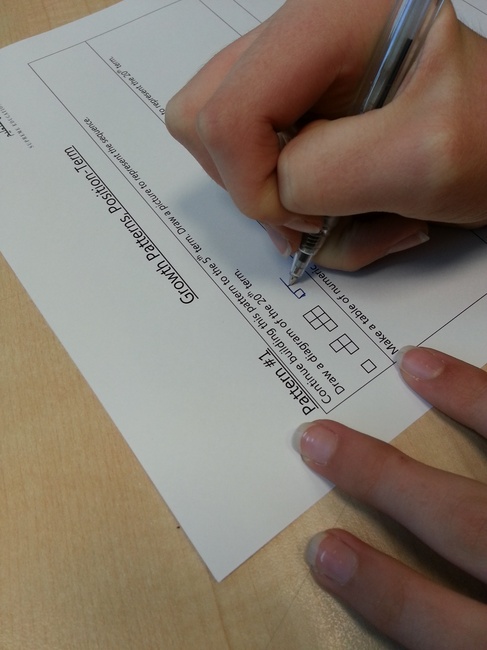OER Fellowship Project: Growth Patterns
Description
This project introduces students to growth patterns; meaning, building, describing numerically and geometrically, predicting next term and finding the nth term (Position-Term Rule) through hands-on activities, practice exercises, simulations, student presentations, discussions, investigations, writing journals, self and peer assessment and gallery walk collaboration strategy. Tactile, visual and auditory learning styles are also used.
Learning Goals
1. Students will recognize the growth pattern.
2. Students will build patterns using tiles and describe the patterns numerically and geometrically.
3. Students will predict the next term in a given pattern.
4. Students will find the nth term (Position- Term Rule) of a given pattern.
5. Students will plot the nth term rule and relate it with the equation of a straight line to find the slope and the y-intercept.
6. Students will relate the growth patterns with real life.
Depth of Knowledge
The students will be engaged to critical thinking through the main activity of building a pattern given only the first two piles. They will work collaboratively to extend the pattern in more than one way and describe each one numerically and geometrically. They will learn from each other how to build the patterns. They will also make a gallery walk to asses or critique the other groups' patterns. They will also self assess themselves and assess their peers using a special rubric. They will also apply their skills to real-life situations (finding a missing girl).
They will apply all the previous also with the activity of finding the nth term.
SEC Standards
7.8.1 Extend and find missing terms in numeric or geometric patterns or sequences using words, diagrams or symbols (term-to-term or position-to-term rules).
7.8.3 Generalise the relationship between one term of a sequence and the next, or between the number of the term and the term, using words or symbols.
Student Levels & Needs
All students of grade 7.
This lesson for auditory, visual, and tactile learning styles students.
Teacher Preparation
The following teaching strategies will be used:
Tactile learning: Students will use square tiles to build patterns
Yes, And problem solving: Students will encourage each other while problem solving by saying "yes, and..."
Technological interactivity: Students will interact with various simulations to review and practice building patterns.
Collaborative learning: Students will work together in groups and make a gallery walk as a collaboration strategy.
Assessment tools: Students will be assessed using different tools; Writing journals, oral questions, tactile activities, solving worksheets, and making self and peer assessments.
Assessment tools needed for teachers: Teachers will make an assessment checklist to assess the students' capability of the objectives of the lesson. They will also write suitable feedback in the students' worksheets. They will also write a reflection after explaining the lesson, and make short and long term action plans.
Materials Needed
Square Tiles ( 1 bag of 1 color/group)
A3 Growth patterns, Introduction Activity Sheet (1/group)
Growth Patterns, Self/Peer Assessment (1/student)
Growth Patterns, Introduction worksheet (1/student)
Growth Patterns, Introduction Lesson Plan ( 1 copy for teacher)
Assessment Checklist (1 copy for teacher)
Growth Patterns, 20th Term lesson plan (1 copy for teacher)
Growth Patterns, 20th Term Handout (1/student)
Tablets to explore the simulations (1/student)
Graphing paper (4/student)
Power point (1 copy for teacher)
Time Needed
Time needed for preparation: 10 minutes
Time needed for lessons, activities, and assessment: Four 50 minute class periods
Project Lessons & Activities
Starter:
Interactive Media & Technology:
Lesson Plans and Powerpoint:
first and second periods
Third and fourth periods
Activities, Practice Exercises & Worksheets:
(first period)
(Second period)
(Third period)
(Fourth period)
Vocabulary
Pattern, term to term rule, position- term rule, nth term.
Assessment
Five kinds of assessment is given to the students:
1) Oral Questions. (Written in the lesson plans above)
2) Writing Journals: (In the worksheet above " Introduction to Growth Patterns Activity Sheet")
3) Worksheets: (In the growth patterns worksheet above and the growth patterns, 20th term worksheet above also)
4) Tactile Activity. (Written in the lesson plans above)
5) Self and Peer Assessment: ( In the growth patterns, self-peer assessment above and the 20th term worksheet above also)
Assessment Checklist for the first lesson plan:
How to provide feedback to students:
Student Work

Student Data
Assessment Checklist:
Teacher reflection:
Short and long term action plans:
Additional Resources
Extensions:
In the first lesson plan, there is an extension to deduce the 20th term.
In the second lesson, there is an extension of graphing the patterns then deduce the slope and the y-intercept from the equations.